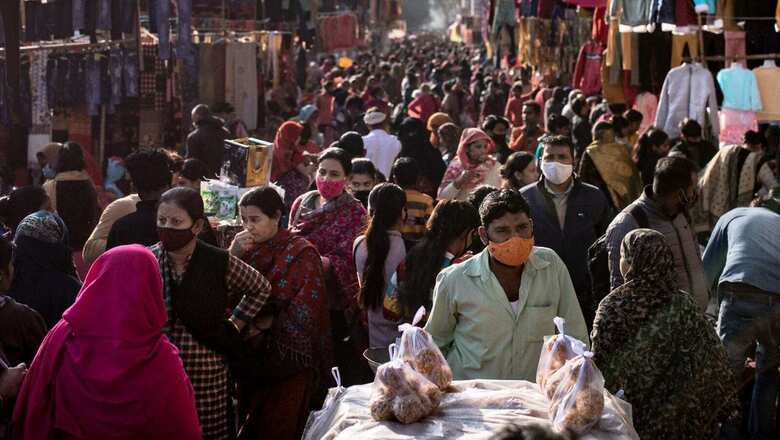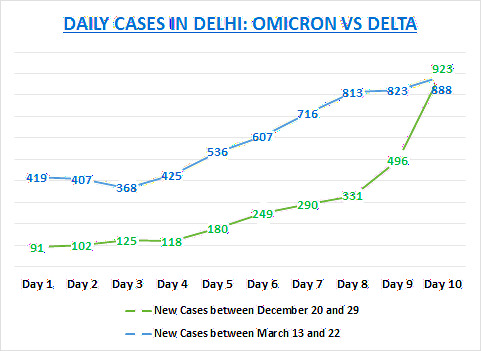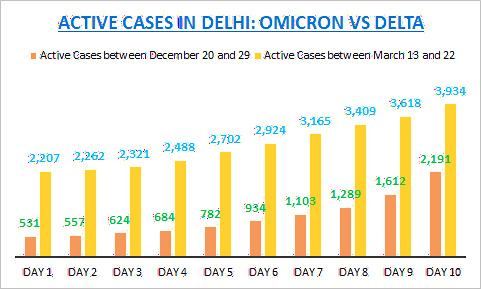
views
Covid-19 cases in Delhi are increasing more rapidly than in the second wave that pushed the health infrastructure of the national capital to the brink April-May this year. The rise in cases comes with the spread of the new Omicron variant, flagged by global health authorities as more transmissible than the Delta variant which had triggered the second wave.
On Wednesday, Delhi reported 923 fresh Covid-19 cases, a jump of more than 10 times since December 20 when the city had reported 91 fresh cases.
The Delhi State Health Bulletin for Covid-19, released by the city’s Health Department every day since the outbreak of the infection, shows that between March 13 and March 22 this year, the daily cases had doubled from 419 to 888. This period is taken for comparison vis-à-vis the current rise since from March 23, the daily cases had crossed the 1,000-mark.

Not just daily cases, but the jump in active cases is also drastic this time. Active cases in the last 10 days have seen more than four times increase while during the said period in the second wave it increased by over 1.5 times, official data analysed by CNN-News18 shows.
However, it is also important to note that while the active cases on December 20 were 531 and had increased to 2,191 on December 29, during the second wave, the jump was from 2,207 to 3,934 on the said dates.

Despite more infections being reported, low hospitalisation rate is a silver lining for the national capital. As on date, 262 hospital beds are occupied in Delhi, including patients suspected to have Covid-19. On December 20, 197 hospital beds were occupied.
So, while the city has reported 2,905 cases in the last 10 days, the occupancy of beds has increased by only 65. The city has 8,965 hospital beds dedicated for coronavirus-infected patients. The bed occupancy rate is nearly 3% as per latest numbers, which means 97% beds are vacant.
During the second wave, on May 10, bed occupancy was around 86% after witnessing a sudden surge. On March 13, just 582 beds were occupied in the city. On March 22, Delhi had 5,728 dedicated hospital beds for coronavirus, of which 967 were occupied.
A month later, on April 22, Delhi increased its bed capacity to 20,191, and of these, 18,154 were occupied. The active cases at that time had touched 91,618.

Learning from the devastating second wave, authorities in August introduced a colour-coded action plan for Delhi under which the level of restrictions in markets, industries, offices and public transport were determined based on the Covid-19 test positivity rate, new cases, and occupancy of oxygen beds in hospitals.
The restrictions are classified as ‘Yellow’, ‘Amber’, ‘Orange’ and ‘Red’ with ‘Yellow’ being the first level of restrictions and ‘Red’ bringing the entire city under complete lockdown.
On Tuesday, Delhi imposed restrictions under the ‘Yellow’ category. The Delhi Disaster Management Authority has decided that it will wait and watch hospitalisation rates and other parameters before sounding the ‘Amber’ alert and increasing restrictions.
The city’s positivity rate stood at 1.29% on Wednesday. The positivity rate –percentage of samples that return positive — was above 0.5% for two days, triggering the ‘Yellow’ alert.
Announcing the alert, Delhi Chief Minister Arvind Kejriwal had assured the city that the government is “10 times more prepared” than before to deal with the rise in Covid cases. He added that the latest Covid-19 cases were mild and there was no increase in the consumption of oxygen or the use of ventilators despite the rise in numbers.
So far, Delhi has recorded the highest number, accounting for 30%, of Omicron cases in India. Out of 781 cases of the new variant reported across the country, Delhi has recorded 238. Of these, 57 were either discharged or recovered or migrated, official data shows.
Read all the Latest India News here


















Comments
0 comment